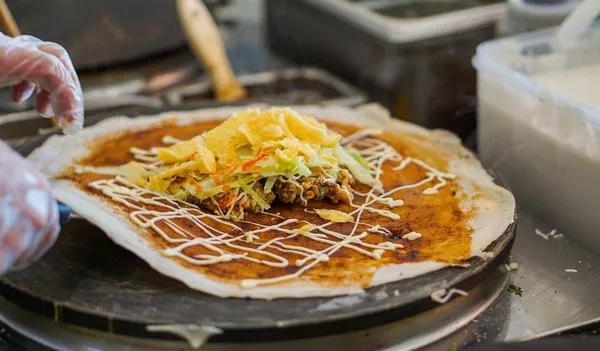Jianbing, often referred to as Chinese crepes, is a popular street food that originates from Northern China. This savory delight has become a staple breakfast option across China, appreciated for its versatility, flavor, and the skill required to prepare it. In this comprehensive guide, we will explore the history, ingredients, preparation, and variations of jianbing, along with some expert tips to perfect your own version at home.
History and Cultural Significance
Jianbing has a rich history that dates back over 2,000 years. It is believed to have originated during the Three Kingdoms period (220–280 AD). According to legend, Zhuge Liang, a chancellor of the state of Shu Han, instructed his soldiers to cook a batter on a flat griddle when they had lost their woks. This improvisation led to the creation of jianbing, which quickly became popular due to its simplicity and satisfying taste.
Over centuries, jianbing has evolved from a soldier’s sustenance to a beloved street food, often enjoyed for breakfast. It holds cultural significance as a symbol of Northern Chinese culinary tradition and is now embraced in various forms across China and around the world.
Ingredients: The Building Blocks of Jianbing
The beauty of jianbing lies in its simplicity and the balance of its components. Here are the essential ingredients needed to make traditional jianbing:
1. Batter
- Mung Bean Flour: Traditionally used for its unique flavor and texture.
- All-Purpose Flour: Adds structure and helps in achieving the desired consistency.
- Water: To mix with the flours and create the batter.
- Eggs: Integral for binding and adding richness.
2. Fillings and Condiments
- Youtiao (Chinese Fried Dough): Adds crunchiness.
- Lettuce: Provides a fresh, crisp contrast.
- Scallions: For a hint of sharpness.
- Cilantro: Adds a burst of freshness.
- Crispy Wonton Strips or Crackers: Alternative to youtiao, adding a different kind of crunch.
- Sweet Bean Sauce: Essential for the traditional sweet-savory flavor.
- Fermented Chili Bean Paste: Adds a spicy kick.
- Hoison Sauce: For extra depth of flavor.
3. Optional Add-Ons
- Ham or Sausage: For added protein.
- Shredded Chicken: Another protein option that pairs well.
- Cheese: A modern twist.
- Pickled Vegetables: Adds tanginess.
Preparation: Step-by-Step Guide to Making Jianbing
Creating jianbing involves several steps, each requiring attention to detail to ensure the final product is both authentic and delicious. Here is a step-by-step guide to making jianbing at home:
1. Preparing the Batter
- Mix the Flours: In a large mixing bowl, combine 1 cup of mung bean flour with 1 cup of all-purpose flour. This combination ensures the right balance of flavor and texture.
- Add Water: Gradually add 2-2.5 cups of water to the flour mixture, whisking continuously to avoid lumps. The batter should be smooth and slightly runny.
- Rest the Batter: Let the batter rest for at least 30 minutes. This resting period allows the flours to fully hydrate and results in a smoother crepe.
2. Cooking the Crepe
- Heat the Griddle: Heat a flat griddle or non-stick pan over medium-high heat. It should be hot enough to cook the batter quickly but not so hot that it burns.
- Spread the Batter: Pour a ladleful of batter onto the griddle. Use a crepe spreader or the back of a ladle to spread the batter thinly and evenly across the surface.
- Add the Egg: Crack an egg directly onto the crepe and use a spatula to spread it evenly over the surface. This step helps bind the crepe and adds richness.
- Sprinkle Scallions and Cilantro: While the egg is still wet, sprinkle chopped scallions and cilantro over the top. This infuses the crepe with fresh, aromatic flavors.
3. Adding Fillings and Condiments
- Apply the Sauces: Once the egg is set, spread a thin layer of sweet bean sauce and fermented chili bean paste over the crepe. Adjust the amount according to your taste preference.
- Add Crunchy Elements: Place a piece of youtiao or a handful of crispy wonton strips/crackers in the center of the crepe. This adds the signature crunch that makes jianbing so enjoyable.
- Layer Fresh Ingredients: Add a few lettuce leaves for freshness and any optional fillings you prefer, such as ham, sausage, or pickled vegetables.
4. Folding and Serving
- Fold the Crepe: Fold the sides of the crepe over the fillings to enclose them. Traditionally, the crepe is folded into a rectangular or square shape.
Serve Immediately: Jianbing is best enjoyed fresh off the griddle when it’s still hot and crispy. Serve it immediately and savor the delightful combination of textures and flavors.
Variations of Jianbing: Exploring Regional and Modern Twists
Jianbing is a versatile dish, and its variations reflect the diversity of Chinese cuisine. Here are some popular regional and modern twists on the traditional jianbing:
1. Tianjin Jianbing
Originating from Tianjin, this variation uses a different batter mix that includes mung bean flour, millet flour, and sometimes corn flour. Tianjin jianbing often features more complex fillings, such as sliced sausage, and is known for its larger size.
2. Shandong Jianbing
Shandong-style jianbing is characterized by its thin and crispy crepe. The batter is made primarily of wheat flour, and the fillings often include shredded potatoes and other local vegetables.
3. Jianbing Guozi
This variation is popular in Beijing and combines jianbing with guozi, which are thin, crispy crackers. The result is an extra-crispy texture and a delightful blend of flavors.
4. Modern Twists
- Cheese Jianbing: Incorporating cheese into jianbing adds a creamy texture and a rich flavor that complements the traditional ingredients.
- Vegetarian Jianbing: For a vegetarian version, fillings like tofu, mushrooms, and a variety of fresh vegetables can be used.
- Fusion Jianbing: Modern chefs have experimented with fusion jianbing, incorporating ingredients like avocado, smoked salmon, and even bacon to create new and exciting flavor combinations.
SEE ALSO: How to Make Hot Sour Soup
Expert Tips for Perfecting Jianbing
Making jianbing at home can be a rewarding experience, but it requires some practice to perfect. Here are some expert tips to help you along the way:
1. Consistency of the Batter
The batter should be smooth and slightly runny, similar to pancake batter. If it’s too thick, the crepe will be dense and heavy. If it’s too thin, it will be difficult to spread and may tear.
2. Even Spreading
Use a crepe spreader or the back of a ladle to spread the batter evenly on the griddle. This ensures that the crepe cooks uniformly and has the right texture.
3. Controlling the Heat
Maintaining the right temperature is crucial. If the heat is too high, the crepe will cook too quickly and burn. If it’s too low, the crepe will be undercooked and soggy.
4. Timing the Fillings
Add the fillings and condiments while the crepe is still cooking on the griddle. This allows the flavors to meld together and ensures that the fillings are heated through.
5. Freshness is Key
Jianbing is best enjoyed immediately after cooking. The contrast between the crispy crepe and the fresh fillings is one of the highlights of this dish, and it diminishes if the jianbing sits for too long.
Serving and Enjoying Jianbing
Jianbing is typically enjoyed as a quick, on-the-go breakfast, but it can also be a delightful snack or light meal at any time of the day. Here are some serving suggestions:
1. Pairing with Beverages
- Soy Milk: A traditional accompaniment that complements the savory flavors of jianbing.
- Tea: Both hot and iced teas, such as jasmine or oolong, are excellent choices.
- Fresh Juice: For a refreshing contrast, pair jianbing with fresh orange juice or a vegetable juice blend.
2. Serving for Different Occasions
- Breakfast: Serve jianbing as a hearty breakfast option with a side of fresh fruit.
- Lunch: Pair jianbing with a light salad or soup for a balanced meal.
- Snacks: Cut jianbing into smaller pieces and serve as an appetizer or snack for gatherings.
Conclusion
Jianbing is more than just a street food; it’s a culinary experience that combines history, culture, and flavor in every bite. By understanding the ingredients, mastering the preparation techniques, and exploring the various regional and modern variations, you can bring the authentic taste of China’s beloved jianbing into your own kitchen.
Whether you stick to the traditional recipe or get creative with your own twists, the joy of making and eating jianbing lies in its simplicity and the satisfaction of crafting a delicious, crispy, and flavorful crepe. So, gather your ingredients, heat up your griddle, and embark on the delightful journey of making jianbing at home.
Related Topics:


























